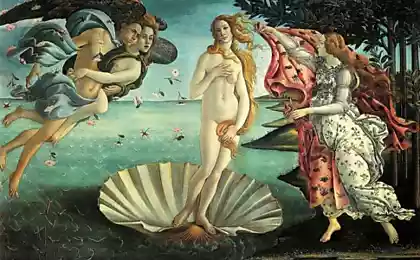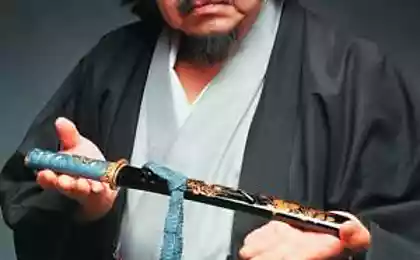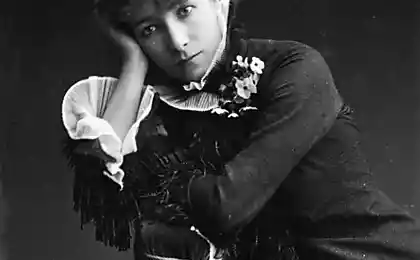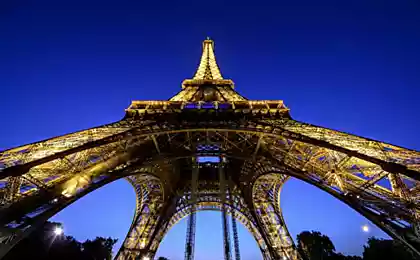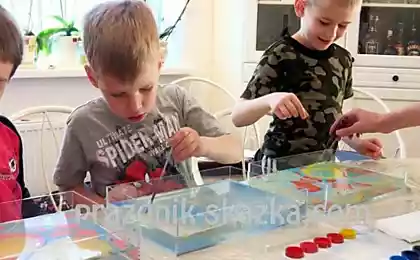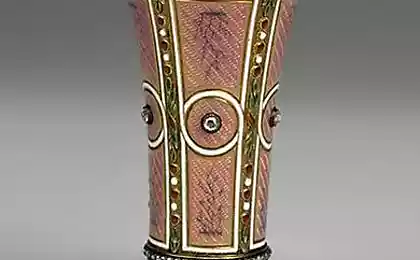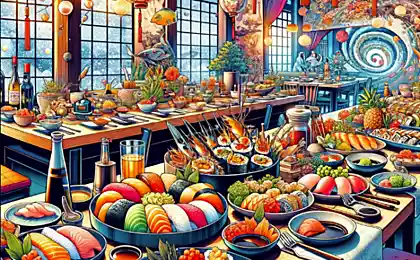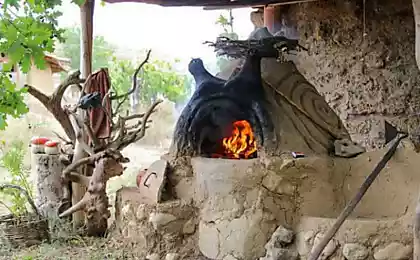1053
Bernard Palissy - master of the French Renaissance
Bernard Palissy (~ 1510 - July 4 1589/1590). Faience.
French revere him as we Lomonosov, his work in the Louvre had a full room.
Simple potter, potters, Palissy began izobretalelem, painter, physicist, chemist, agronomist, one of the founders of modern geology and paleontology.
Palissy worked faience, enamels, glazes, published a treatise "On the gocharnom art, his favor, on the enamel and fire" (1580). He studied and published prizvodstvennyh many mysteries and secrets, but left and its: a number of recipes his glazes are not disclosed to this day.
Bernard Palissy lived a long working life, and in the end it was thrown into the dungeons of the Bastille, as the Huguenots. There he died.
source
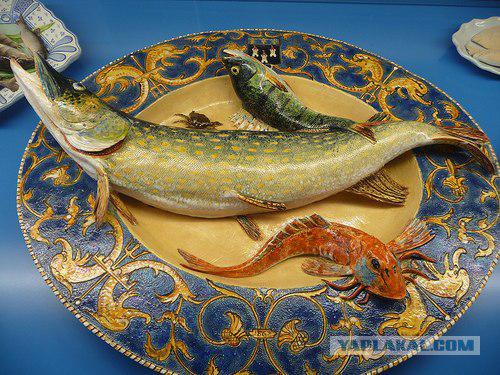
He was born in the south of France, in a small village near the small town of Biron. In his early youth, he traveled extensively in the Pyrenees, the Ardennes and the banks of the Rhine. A simple worker, he shifted from place to place, at the same time engaged in a craft glassmaker, potter and a surveyor.
Palissy recalled how once during the journey, he had wandered into some abandoned shop, where he saw "a clay bowl, performed so well that I was confused».
Trying to understand the secret of the white ground, covered the bowl, Palissy settled in the town of Saint near Bordeaux, hosts here furnace.
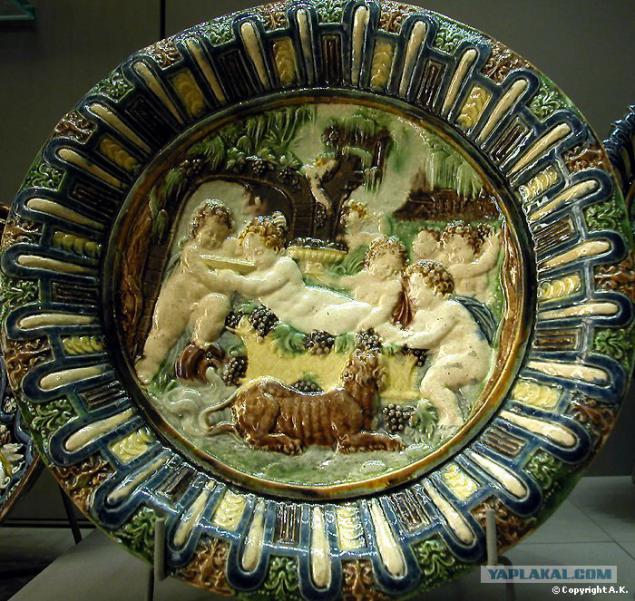
The first experiments he failed, he carries around and puts a brick, burn lime, carrying water from the well. The oven is ready. Palissy is prepared enamel and begins to float it. Standing in front of the fire 6 days and 6 nights Palissy puts firewood. Fuel is not hvataet- Palissy then begins to throw on the fire props of fruit trees, furniture, breaks out and throws into the furnace of the board of the house. We laughed at neighbors and shopkeepers deprived of credit. Palissy found himself on the street with two babies and deep in debt.
"Hope does not leave me. I started to work again, trying to keep the fun kind of ... ».
"I suffered a new disaster. Under the influence of heat, cold, wind and rain spoiled most of my work before, than she was prepared ».
"For several years, with no means to make canopies over my furnace, I spent their night in the rain and wind ... No one came to help me, nobody gave me support from no one I heard words of comfort, and the only meowing cats but dogs howling comforted my ears at night ... ".
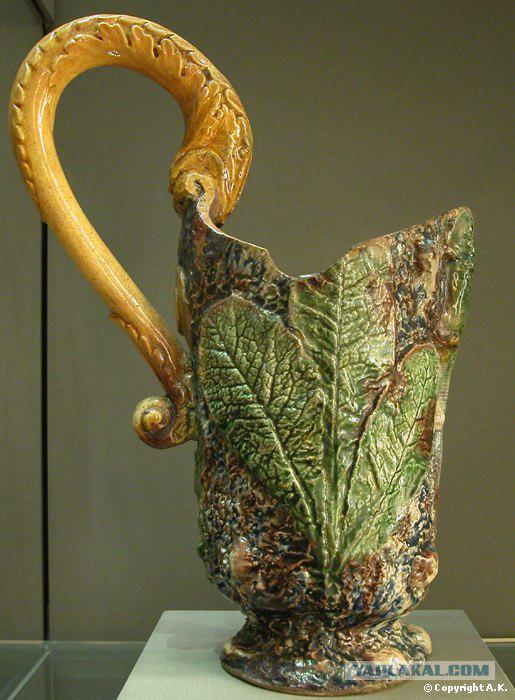
Palissy set a goal - to get unprecedented before icing, which should combine the glaze of different colors. The task is difficult, because the glaze melts of different colors at different temperatures. The plan fails, and Palissy received the famous "speckled" glaze, resembling marble with multi-colored sparks, and manufactures "rural" bowl - filled with images of plants and animals. Gradually he makes their products in highly artistic works of art. Its vessels are decorated with small animals, insects, plants, snakes, fish, life-size. They give the impression of living. Then, in the master's works appear scenes from classical mythology.
As a result, 15-year quest Palissy in 1550-ies. It offers a special way of decorating pottery, which he called "rural clay."
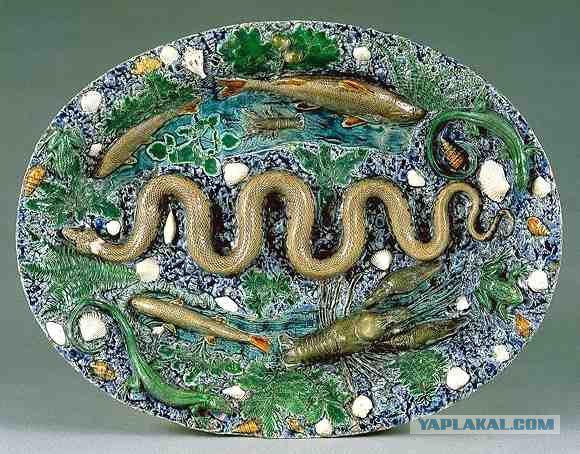
Palissy thought that the secrets of his art should not be in the public domain, and, calling the composition of enamels, refuses to mix-dose (he said that in the glazes include oxides of tin, lead, iron, antimony, copper, as well as sand and soda). He argues that "it is not a mechanical process here requires a special geometry." Mystery technology "rural clay" has remained unsolved. Many have tried to "explain" the technology amazing masterpieces Palissy, but the "reconstruction" are fantastic character.
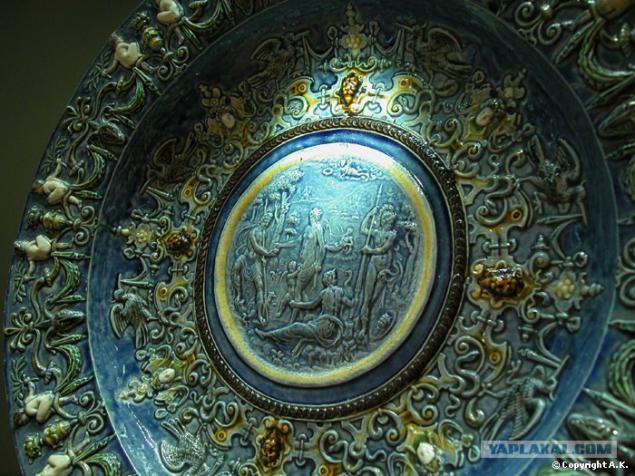
Palissy workshop creates, but "rural clay" his workshop produced (without a potter's wheel, by pressing in forms) decoration with allegoriko-mythological compositions of motifs borrowed from the art of metal. His magnificent dishes and beautiful statues were appreciated and sold out like hot cakes. He is invoked with the order of King Henry II of France and all-powerful lords.
1564.
At the invitation of King Palissy he moved to Paris, where he works as a ceramist (was appointed "inventor rural figures for the king and queen mother" - that is, for Catherine de Medici and Charles IX). Catherine de Medici put him in the Tuileries, where the inventor took up finishing the royal palaces.
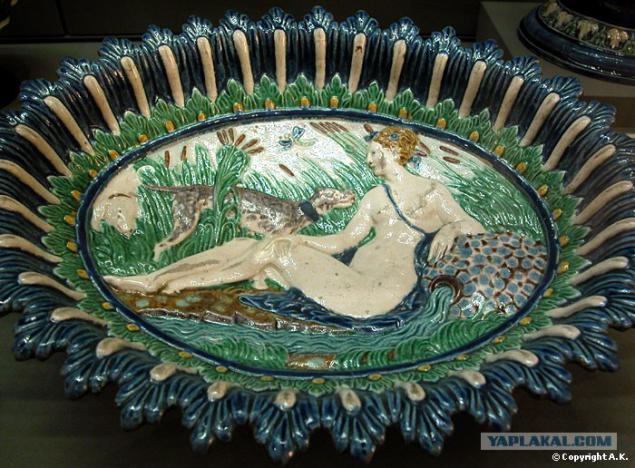
Help.
"Rural clay" ("figures") - earthenware large, shallow, always oval dishes with wide straight edges, decorated with motifs of nature (impressions from life images of fish, shells, green, snakes, lizards and frogs). Palissy was "jasper icing," features more transparency and depth of tone. It is dominated by blue, green and purple-brown color.
Releasing boxed decorative utensils, Palissy used similar "clay" in the future and for the registration of garden grottoes in Ekuane near Paris (1562) and the Palace of the Tuileries (1570).
Its products are actively copied later, especially in the 17th century. And 19 in., When there was a whole school of ceramics "palissistov."
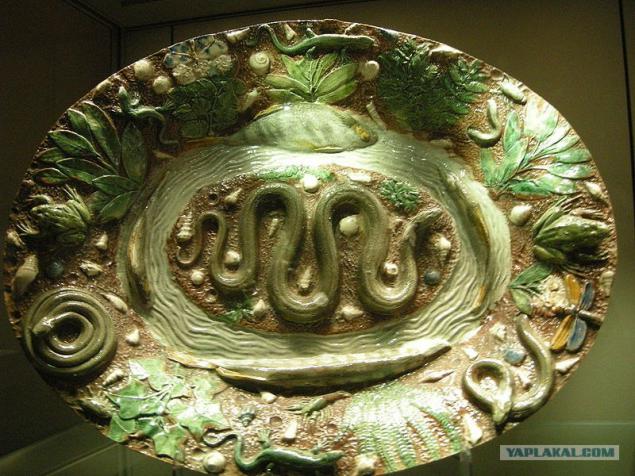
In Paris, he founded the "natural history room," in which during 1575-1585 years. lectures on natural sciences and physics. As a Protestant, a Huguenot, he gave his artistic and scientific pursuits utopian religious connotation, the dream of creating a great country in the form of an underground "garden-seekers", where "true Christians" could escape from persecution.
It also gathers a collection of stones - genuine geological museum.
Palissy was first hypothesized that the shells and other fossils are not a simple game of nature, but are fossils of ancient animals.
He was among the first pointed to the importance of salt in the soil. He claimed that the mineral salts necessary for plant life, and recommended to mix the soluble salt and marl to manure and other organic fertilizers. In 1588 he was imprisoned in the Bastille as the Huguenots. Catherine de Medici patronage saved him from death in the St. Bartholomew's Day. But when in 1588 the League has captured Paris, he was imprisoned in the Bastille. One day he came into the chamber, King Henry III and offered freedom for changing religion. Palissy refused and soon died in the Bastille.
Palissy died in the Bastille in Paris in 1590. In other svedeniyam- he was executed.
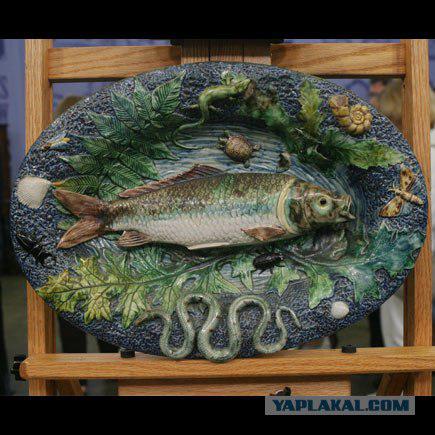
6 more photos, and I still
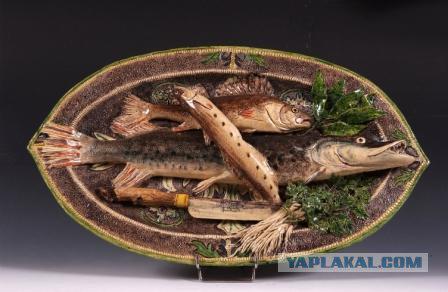
Two
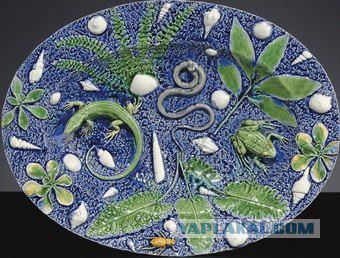
Three
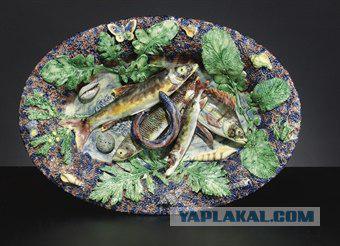
4-D

Five
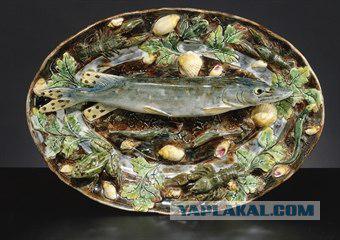
Six
That's all I wanted to say. The site is still very much the primary source of photographs of his works. All copy here no sense.
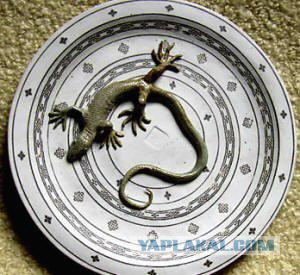
Source:
French revere him as we Lomonosov, his work in the Louvre had a full room.
Simple potter, potters, Palissy began izobretalelem, painter, physicist, chemist, agronomist, one of the founders of modern geology and paleontology.
Palissy worked faience, enamels, glazes, published a treatise "On the gocharnom art, his favor, on the enamel and fire" (1580). He studied and published prizvodstvennyh many mysteries and secrets, but left and its: a number of recipes his glazes are not disclosed to this day.
Bernard Palissy lived a long working life, and in the end it was thrown into the dungeons of the Bastille, as the Huguenots. There he died.
source

He was born in the south of France, in a small village near the small town of Biron. In his early youth, he traveled extensively in the Pyrenees, the Ardennes and the banks of the Rhine. A simple worker, he shifted from place to place, at the same time engaged in a craft glassmaker, potter and a surveyor.
Palissy recalled how once during the journey, he had wandered into some abandoned shop, where he saw "a clay bowl, performed so well that I was confused».
Trying to understand the secret of the white ground, covered the bowl, Palissy settled in the town of Saint near Bordeaux, hosts here furnace.

The first experiments he failed, he carries around and puts a brick, burn lime, carrying water from the well. The oven is ready. Palissy is prepared enamel and begins to float it. Standing in front of the fire 6 days and 6 nights Palissy puts firewood. Fuel is not hvataet- Palissy then begins to throw on the fire props of fruit trees, furniture, breaks out and throws into the furnace of the board of the house. We laughed at neighbors and shopkeepers deprived of credit. Palissy found himself on the street with two babies and deep in debt.
"Hope does not leave me. I started to work again, trying to keep the fun kind of ... ».
"I suffered a new disaster. Under the influence of heat, cold, wind and rain spoiled most of my work before, than she was prepared ».
"For several years, with no means to make canopies over my furnace, I spent their night in the rain and wind ... No one came to help me, nobody gave me support from no one I heard words of comfort, and the only meowing cats but dogs howling comforted my ears at night ... ".

Palissy set a goal - to get unprecedented before icing, which should combine the glaze of different colors. The task is difficult, because the glaze melts of different colors at different temperatures. The plan fails, and Palissy received the famous "speckled" glaze, resembling marble with multi-colored sparks, and manufactures "rural" bowl - filled with images of plants and animals. Gradually he makes their products in highly artistic works of art. Its vessels are decorated with small animals, insects, plants, snakes, fish, life-size. They give the impression of living. Then, in the master's works appear scenes from classical mythology.
As a result, 15-year quest Palissy in 1550-ies. It offers a special way of decorating pottery, which he called "rural clay."

Palissy thought that the secrets of his art should not be in the public domain, and, calling the composition of enamels, refuses to mix-dose (he said that in the glazes include oxides of tin, lead, iron, antimony, copper, as well as sand and soda). He argues that "it is not a mechanical process here requires a special geometry." Mystery technology "rural clay" has remained unsolved. Many have tried to "explain" the technology amazing masterpieces Palissy, but the "reconstruction" are fantastic character.

Palissy workshop creates, but "rural clay" his workshop produced (without a potter's wheel, by pressing in forms) decoration with allegoriko-mythological compositions of motifs borrowed from the art of metal. His magnificent dishes and beautiful statues were appreciated and sold out like hot cakes. He is invoked with the order of King Henry II of France and all-powerful lords.
1564.
At the invitation of King Palissy he moved to Paris, where he works as a ceramist (was appointed "inventor rural figures for the king and queen mother" - that is, for Catherine de Medici and Charles IX). Catherine de Medici put him in the Tuileries, where the inventor took up finishing the royal palaces.

Help.
"Rural clay" ("figures") - earthenware large, shallow, always oval dishes with wide straight edges, decorated with motifs of nature (impressions from life images of fish, shells, green, snakes, lizards and frogs). Palissy was "jasper icing," features more transparency and depth of tone. It is dominated by blue, green and purple-brown color.
Releasing boxed decorative utensils, Palissy used similar "clay" in the future and for the registration of garden grottoes in Ekuane near Paris (1562) and the Palace of the Tuileries (1570).
Its products are actively copied later, especially in the 17th century. And 19 in., When there was a whole school of ceramics "palissistov."

In Paris, he founded the "natural history room," in which during 1575-1585 years. lectures on natural sciences and physics. As a Protestant, a Huguenot, he gave his artistic and scientific pursuits utopian religious connotation, the dream of creating a great country in the form of an underground "garden-seekers", where "true Christians" could escape from persecution.
It also gathers a collection of stones - genuine geological museum.
Palissy was first hypothesized that the shells and other fossils are not a simple game of nature, but are fossils of ancient animals.
He was among the first pointed to the importance of salt in the soil. He claimed that the mineral salts necessary for plant life, and recommended to mix the soluble salt and marl to manure and other organic fertilizers. In 1588 he was imprisoned in the Bastille as the Huguenots. Catherine de Medici patronage saved him from death in the St. Bartholomew's Day. But when in 1588 the League has captured Paris, he was imprisoned in the Bastille. One day he came into the chamber, King Henry III and offered freedom for changing religion. Palissy refused and soon died in the Bastille.
Palissy died in the Bastille in Paris in 1590. In other svedeniyam- he was executed.

6 more photos, and I still

Two

Three

4-D

Five

Six
That's all I wanted to say. The site is still very much the primary source of photographs of his works. All copy here no sense.

Source:
